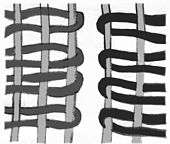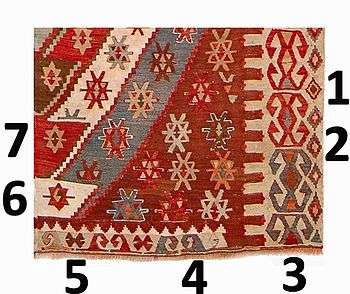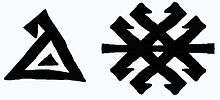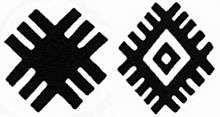Kilim motifs
Many motifs are used in kilims, each with many variations. In Turkish Anatolia in particular, tribal women wove themes significant for their lives into their rugs, whether before marriage or during married life. Some motifs represent desires, such as for happiness and children; others, for protection against threats such as wolves (to the flocks) and scorpions, or against the evil eye. These motifs were often combined when woven into patterns on kilims.
Context
A Turkish kilim is a flat-woven rug from Anatolia. Although the name kilim is sometimes used loosely in the West to include all type of rug such as cicim, palaz, soumak and zili, in fact any type other than pile carpets, the name kilim properly denotes a specific weaving technique. Cicim, palaz, soumak and zili are made using three groups of threads, namely longitudinal warps, crossing wefts, and wrapping coloured threads. The wrapping threads give these rugs additional thickness and strength. Kilim in contrast are woven flat, using only warp and weft threads. Kilim patterns are created by winding the weft threads, which are coloured, backwards and forwards around pairs of warp threads, leaving the resulting weave completely flat. Kilim are therefore called flatweave or flatware rugs.[1]

To create a sharp pattern, weavers usually end each pattern element at a particular thread, winding the coloured weft threads back around the same warps, leaving a narrow gap or slit. These are prized by collectors for the crispness of their decoration. The motifs on kilims woven in this way are constrained to be somewhat angular and geometric.[2]
In tribal societies, kilim were woven by women at different stages of their lives: before marriage, in readiness for married life; while married, for her children; and finally, kilim for her own funeral, to be given to the mosque. Kilims thus had strong personal and social significance, being made for personal and family use. Feelings of happiness or sorrow, hopes and fears were expressed in the weaving motifs. Many of these represent familiar household and personal objects, such as a hairband, a comb, an earring, a trousseau chest, a jug, a hook.[1][3]
Meanings

1) Eye (Göz) / Evil Eye (Nazarlık)
2) Eye, containing Cross (Haç)
3) Ram's Horn (Koçboynuzu)
4) Fertility (Bereket)
5) Wolf's Mouth (Kurt İzi)
6) Star (Yıldız), containing Love and Unison (Aşk ve Birleşim)
7) Star, containing Fetter (Bukaǧı)
The meanings expressed in kilims derive both from the individual motifs used, and by their pattern and arrangement in the rug as a whole.[3] A few symbols are widespread across Anatolia as well as other regions including Persia and the Caucasus; others are confined to Anatolia.[4]
An especially widely used motif is the elibelinde, a stylized female figure, motherhood and fertility.[5][6]
Other motifs express the tribal weavers' desires for protection of their families' flocks from wolves with the wolf's mouth or the wolf's foot motif (Turkish: Kurt Aǧzi, Kurt İzi), or for safety from the sting of the scorpion (Turkish: Akrep).[1] Several protective motifs, such as those for the dragon (Turkish: Ejder), scorpion, and spider (sometimes called the crab or tortoise by carpet specialists) share the same basic diamond shape with a hooked or stepped boundary, often making them very difficult to distinguish.[4][7]
Several motifs hope for the safety of the weaver's family from the evil eye (Turkish: Nazarlık, also used as a motif), which could be divided into four with a cross symbol (Turkish: Haç), or averted with the symbol of a hook (Turkish: Çengel), a human eye (Turkish: Göz), or an amulet (Turkish: Muska; often, a triangular package containing a sacred verse).[1][8] The carpet expert Jon Thompson explains that such an amulet woven into a rug is not a theme: it actually is an amulet, conferring protection by its presence. In his words, "the device in the rug has a materiality, it generates a field of force able to interact with other unseen forces and is not merely an intellectual abstraction."[9]
Other motifs symbolised fertility, as with the trousseau chest motif (Turkish: Sandıklı), or the explicit fertility (Turkish: Bereket) motif. The motif for running water (Turkish: Su Yolu) similarly depicts the resource literally.[1]
The desire to tie a family or lovers together could be depicted with a fetter motif (Turkish: Bukaǧı). Similarly, a tombstone motif may indicate not simply death, but the desire to die rather than to part from the beloved.[1]
Several motifs represented the desire for good luck and happiness, as for instance the bird (Turkish: Kuş) and the star or Solomon's seal (Turkish: Yıldız). The oriental symbol of Yin/Yang is used for love and unison (Turkish: Aşk ve Birleşim).[1]
Among the motifs used late in life, the Tree of Life (Turkish: Hayat Aǧacı) symbolizes the desire for immortality. Many of the plants used to represent the Tree of Life can also be seen as symbols of fruitfulness, fertility, and abundance. Thus the pomegranate, a tree whose fruits carry many seeds, implies the desire for many children.[1]
Symbols are often combined, as when the feminine elibelinde and the masculine ram's horn are each drawn twice, overlapping at the centre, forming a figure (some variants of the Bereket or fertility motif[4]) of the sacred union of the principles of the sexes.[10]
Motifs
All the motifs can vary considerably in appearance according to the weaver. Colours, sizes and shapes can all be chosen according to taste and the tradition in a given village or tribe; further, motifs are often combined, as illustrated in the photographs above.[1] To give some idea of this variability, a few alternative forms are shown in the table.
| Name | Turkish | Motif | Purpose | Object | Notes |
|---|---|---|---|---|---|
| Hands-on-hips motif | Elibelinde | | Motherhood Fertility | Marriage | ♀ principle (4 examples)[1] |
| Cross motif | Haç | | Protection | Evil eye | to divide the evil eye into four (2 examples)[1] |
| Hook motif | Çengel | | Protection | Evil eye | to destroy the evil eye[1] |
| Eye motif | Göz | | Protection | Evil eye | to ward off the evil eye (3 examples)[1] |
| Comb motif | Tarak |  | Protection | Birth, Marriage | (2 examples)[1] |
| Running water motif | Su Yolu |  | Fresh water | Life | very important in tribal life (3 examples)[1] |
| Fertility motif | Bereket | | Fertility | Marriage | Combines ♀ Hands-on-hips, ♂ Ram's horn (2 examples)[1] |
| Ram's horn motif | Koçboynuzu | | Fertility, Power, Masculinity | Marriage | ♂ principle (2 examples)[1] |
| Star motif | Yıldız |  | Fertility, Happiness | Marriage | Solomon's seal[1] |
| Love and Unison motif | Aşk ve Birleşim |  | Love and harmony | Marriage | Derived from Oriental Yin/Yang motif |
| Amulet motif | Muska | | Protection Luck | Evil eye | Contained a verse of scripture (3 examples)[1] |
| Bird motif | Kuş |  | Luck, Happiness, Strength | Life | Owl and raven signify bad luck; pigeon and nightingale, good luck. Also souls of the dead; expectation of news. (2 examples)[1][11] |
| Fetter motif | Bukaǧı |  | Union | Marriage | To tie family or lovers together. The fetter tied front and hind legs of a goat.[1] |
| Trousseau chest motif | Sandıklı |  | Marriage, Children | Marriage | Unmarried women prepared dowry in a chest.[1] |
| Earring motif | Küpe |  | Marriage | - | A common wedding present[1] |
| Wolf's Mouth motif Wolf's Track motif | Kurt Aǧzi Kurt İzi | | Protection of the flocks | Wolves | (2 examples)[1] |
| Scorpion motif | Akrep |  | Protection | Scorpions | (2 examples)[1] Similar motifs are used for other animals such as Spider, Crab and Dragon.[4][7] |
| Dragon motif | Ejder | | Protection? | - | Dragon is "master of air and water",[1] cause of lunar eclipse, guard of treasure. (4 examples)[1] |
| Tree of life motif | Hayat Aǧacı |  | Immortality | - | Many different plants may be represented, e.g. beech, cypress, fig, oak, olive, palm, pomegranate, vine[1] |
| Burdock motif | Pitrak |  | Protection, Abundance | Evil eye | Plant is used to ward off evil eye. With many flowers, it symbolizes abundance.[1] |
References
- 1 2 3 4 5 6 7 8 9 10 11 12 13 14 15 16 17 18 19 20 21 22 23 24 25 26 27 28 29 30 Erbek, Güran (1998). Kilim Catalogue No. 1. May Selçuk A. S. Edition=1st. pp. 4–30.
- ↑ Davies, Peter (2000). Antique kilims of Anatolia. W.W. Norton & Co. ISBN 978-0-393-73047-0.
- 1 2 Taskiran, Nurdan. "Reading Motifs on Kilims: A Semiological Approach to Symbolic Meaning" (PDF). Yeditepe.edu.tr. Retrieved 22 January 2016.
- 1 2 3 4 "Carpet Motifs: A Beginner's Guide". Arastan. 9 May 2012. Retrieved 22 January 2016.
- ↑ "Hands on Hips - Elibelinde". Retrieved 24 February 2014.
- ↑ Unal, Sahika (August 2009). "Symbolic Meanings and Characteristics of Anatolian Kilims" (PDF). Retrieved 22 January 2016.
- 1 2 Anquetil, Jacques (2003). Carpets Techniques Traditions and History. Hachette. pp. 40–43. ISBN 978-1-844-30012-9.
- ↑ "Kilim Motifs". Kilim.com. Retrieved 22 January 2016.
- ↑ Thompson, Jon (1988). Carpets from the Tents, Cottages and Workshops of Asia. Barrie & Jenkins. p. 156. ISBN 0-7126-2501-1.
- ↑ Özyurt, Üzeyir. "The Language of Kilim of Anatolia" (PDF). Dervish Brothers. Retrieved 22 January 2016.
- ↑ "Bird - Kus". Kilim.com. Retrieved 23 January 2016.

